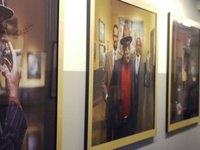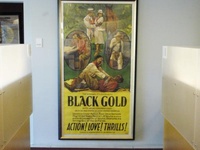
The DuBois Institute for African and African-American Research houses numerous pieces of art noteable for their social and political import. The collection is located nearby, albeit in a hard-to-find office on Mt. Auburn Street.
Langston Hughes is naked in front of me.
Rather, actor Ben Ellison, portraying Hughes in the 1988 film essay “Looking for Langston,” is laying nude in the film’s poster with Matthew Baidoo, who plays Hughes’ lover, James Baldwin. They are intertwined in a seemingly post-coital embrace, an image emblematic of the rest of the art on exhibition at the W. E. B. Du Bois Institute for African and African American Research.
For a year now, the Du Bois Institute has explored black history and culture in new digs at 104 Mt. Auburn St.—a plain office building a few doors down from Peet’s Coffee—occupying floors 2R, 3R, and 4R.
On your way to Darwin’s, an IOP lecture, or the A.R.T., it’s easy to overlook. But the art housed in the institute is a powerful—albeit eclectic—chronicle of black culture, offering both snapshots and panoramic views.
BETWEEN SHADOW AND LIGHT
The Du Bois Institute’s de facto gallery room is a small, oddly shaped space near the main reception area on floor 3R, plastered wall-to-wall with black-and-white photographs taken by Indian photographer Sunil Gupta during the “Looking for Langston” film shoot in 1989.
Gupta places the black men that occupy his frames in a realm between shadow and light, neither relegating them to the darkness nor allowing them to fully emerge from obscurity.
A prior viewing of the film isn’t necessary to enjoy the exhibit, which will be on display until January 2007. “Looking for Langston” is rare in the U.S., and doesn’t follow a typical plot structure.
“There’s not a conventional narrative,” says Sheldon L. Cheek, curator of the exhibit and of the Du Bois Institute’s permanent collection. Instead, British filmmaker Isaac Julien strings together ten scenes to paint a portrait of a lesser-known side of the Harlem Renaissance.
“It was made at a time in both England and America when the Harlem Renaissance was really well known but the fact that a lot of these artists were gay was not,” Cheek says.
He includes a handful of production shots, exposing the sets, cameras, and lights behind the artistry.
Most of Gupta’s work, however, deals in portraiture, blending two black men while distinguishing them from the shadows that permeate the pictures’ backgrounds.
In one aberrant, haunting print, however, a white man reclines in post-coital bliss on a chaise lounge, his eyes closed, while casually handing money to a muscular black man smothered in dark shadows.
“He looks very resigned,” says Cheek, referring to the black man. “It’s a very slow tableau.”
Gupta’s photography captures this sense of dilatory movement by usually leaving one body part hanging in the air, in mid-action. A series of three stills taken in quick succession leaves a large naked torso hanging in the foreground while Hughes struts behind.
Gupta’s men are active and dynamic—putting them in stark contrast to the social system that stifled them. Julien’s film, which is playing on repeat alongside Gupta’s photographs, portrays them in a similar light, infusing subtle AIDS-crisis activism into the story of Hughes and Baldwin.
“He’s remembering Langston Hughes and James Baldwin, but also sort of projecting his contemporary stance on that,” says Cheek.
UNASSUMING INTENSITY
Out in the hallways that snake between the offices of the Du Bois Institute faculty lies the permanent art collection—a motley assortment of paintings, posters, and sculptures—that memorialize many moments in the history of Africans, African-Americans, and the institute itself.
Some of the posters are reminders of the august figures that the Institute has hosted. Particularly memorable are Nigerian Nobel Prize-winner Wole Soyinka’s many lectures at Harvard (including a series with fellow Nobel laureate Toni Morrison) and a discussion on jazz and American culture featuring documentary filmmaker Ken Burns and Institute Director and Fletcher University Professor Henry Louis Gates Jr.
But most of the reminders of the Institute’s impressive visits are hidden in dark, back hallways. Relegating these posters to slight obscurity was a prudent choice on Cheek’s part, as the lack of exposure saves the art exhibition from any undercurrent of self-congratulatory hubris.
The most powerful pieces speak to twentieth century African-American cultural heritage. A 1920’s advertisement depicting a subservient black waiter serving a chocolate concoction stands next to several modern deconstructions of other such exploitations of black culture in marketing.
“Black artists are looking at this old racist imagery and reinterpreting it, seeing it ironically,” says Cheek.
A sticky point in black artistry is explored downstairs on floor 2R in a vast collection of “blaxploitation” film posters, some of which are from Fletcher University Professor Henry Louis Gates, Jr.’s private collection.
Even though blaxploitation films were made largely by blacks for a black audience, hindsight has given them a negative cultural connotation because of their relentless stereotyping of black men as violent, sexist, drug abusers and their pandering to a large demographic of black urban youth.
“Some [black actors] were criticized for playing stereotypical violent roles as black men,” Cheek says. “But it’s probably a good film,” he hastened to add, separating the any given blaxploitation film’s artistic merit from its social ethics. Unfortunately, access to floor 2R is restricted to guests with an Institute escort.
One of the most powerful images in the collection, however, is open for public viewing on the main floor. At the end of a hallway next to a few offices hangs a picture of Martin Luther King, Jr., done entirely in harsh, angry pencil lines. King looks almost tired and weary in this unusual portrait, perhaps an extrapolation of his mental state towards the end of his life.
“Usually, the images you see on photographs or works of art are much more one-dimensional. Here, it’s almost sort of haunting, like a foreboding of his death,” says Cheek, in awe of the picture’s unassuming intensity.
This quality is present in varying degrees throughout the art in the Du Bois Institute’s collection. Finding the Institute may be difficult, but the hunt bears rewards beyond its pains.
—Staff writer Kyle L. K. McAuley can be reached at kmcauley@fas.harvard.edu
Read more in Arts
Portrait: Tom Conley














